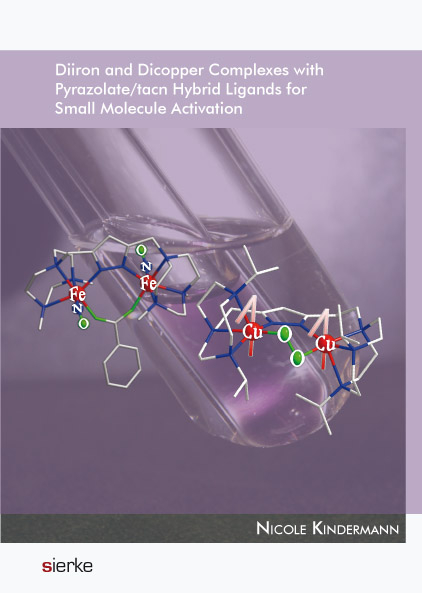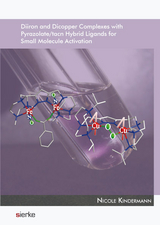Diiron and Dicopper Complexes with Pyrazolate/tacn Hybrid Ligands for Small Molecule Activation
Seiten
2017
sierke VERLAG - Sierke WWS GmbH
978-3-86844-914-3 (ISBN)
sierke VERLAG - Sierke WWS GmbH
978-3-86844-914-3 (ISBN)
The presence of metal-containing enzymes is ubiquitous in
nature. Besides structural stability that metals might exert
on the protein backbone, their Lewis acidity and/or the redox
activity provide an excellent basis to perform catalytic
transformations of all kinds. In order to unveil the underlying
mechanisms, low molecular weight analogues have been
developed by bioinorganic chemists and studied by various
techniques. The focus of this dissertation is the development
of novel dinuclear iron and copper complexes as bioinspired
models for non-heme diiron and type-3 copper proteins.
These proteins contain dinuclear centers in the respective
active site, and are known to activate small molecules such
as dioxygen or nitric oxide. Using ligand scaffolds based on
pyrazole and triazacyclononane (tacn), the isolation of diiron
and dicopper complexes is achieved, mimicking biologically
relevant metallosites in biomolecules. A detailed analysis of
the compounds by X-ray diffraction and by various spectroscopic
techniques, e.g. UVvis, FTIR, (resonance) Raman and
Mössbauer spectroscopy, is given. In addition, their reactivity
towards small molecules, the characterization of adducts
and their further transformation, i.e. by redox or acid-base
chemistry, are described.
nature. Besides structural stability that metals might exert
on the protein backbone, their Lewis acidity and/or the redox
activity provide an excellent basis to perform catalytic
transformations of all kinds. In order to unveil the underlying
mechanisms, low molecular weight analogues have been
developed by bioinorganic chemists and studied by various
techniques. The focus of this dissertation is the development
of novel dinuclear iron and copper complexes as bioinspired
models for non-heme diiron and type-3 copper proteins.
These proteins contain dinuclear centers in the respective
active site, and are known to activate small molecules such
as dioxygen or nitric oxide. Using ligand scaffolds based on
pyrazole and triazacyclononane (tacn), the isolation of diiron
and dicopper complexes is achieved, mimicking biologically
relevant metallosites in biomolecules. A detailed analysis of
the compounds by X-ray diffraction and by various spectroscopic
techniques, e.g. UVvis, FTIR, (resonance) Raman and
Mössbauer spectroscopy, is given. In addition, their reactivity
towards small molecules, the characterization of adducts
and their further transformation, i.e. by redox or acid-base
chemistry, are described.
| Erscheinungsdatum | 06.07.2017 |
|---|---|
| Verlagsort | Göttingen |
| Sprache | englisch |
| Maße | 148 x 210 mm |
| Gewicht | 270 g |
| Einbandart | geklebt |
| Themenwelt | Naturwissenschaften ► Chemie ► Anorganische Chemie |
| Schlagworte | Aktivierung kleiner Moleküle • Bioanorganik • Eisen • Kupfer • Molekülspektroskopie • Pyrazolliganden • Sauerstoff • Stickstoffmonoxid • Triazacyclononane |
| ISBN-10 | 3-86844-914-0 / 3868449140 |
| ISBN-13 | 978-3-86844-914-3 / 9783868449143 |
| Zustand | Neuware |
| Haben Sie eine Frage zum Produkt? |
Mehr entdecken
aus dem Bereich
aus dem Bereich
Buch | Hardcover (2024)
Springer Spektrum (Verlag)
CHF 89,95




